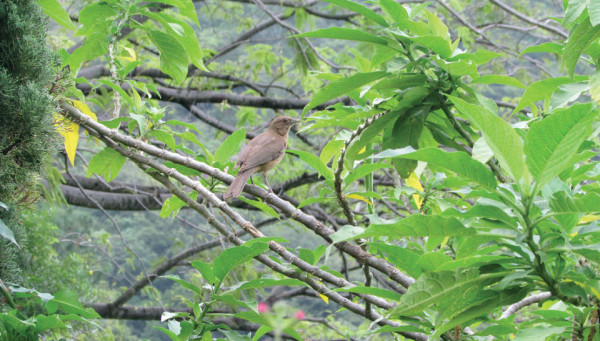Tony
Tony’s tuned up and ready to begin his annual concert series for you to enjoy this month and on into May. Tony has been resting, eating well and repairing his home the last few months while studying his musical scores. Shortly before dawn one morning soon, you will hear him warming up for his season of song. You can’t miss hearing him, even if you dislike classical melodies awakening you. He’s loud. Though small in size, his full-throated voice carries dramatically through his concert hall, which stretches from the Rio Grande Valley of south Texas across Mexico and Middle America into Colombia.
Guatemalans know Tony as a yigüirro. His concerts starting in February are said to call forth the rain, and indeed Tony continues performing until the start of invierno, the rainy season.
Tony used to be classified by ornithologists as a type of robin, because he’s the size and shape of the American robin, but now he’s correctly called a thrush—a clay-breasted thrush, to be exact.
Clay isn’t a very exciting color, and indeed Tony looks sort of like dried mud on a riverbank. He makes up for appearances with his superb sound quality, beautiful enough that our Costa Rican neighbors selected him from among the many more colorful types in their jungles as their national bird.
To us he’s Tony, named after a handsome godson studying architecture in Guatemala. Both Tony’s sing to impress the ladies. It works, at least in attracting female thrushes each year. Tony—the bird, not the godson—has built a splendid nest atop the cedar in our back yard, high enough to be safe from predators. When his concert series ends for the season, Tony rebuilds, redecorates and reuses the same nest each year.
In February Tony starts an elaborate early-morning “cheerio” melody to impress the lady thrushes. Several visit each week to inspect the real estate as well as the potential mate. Tony’s lust keeps him singing loudly each morning until the perfect mother of his annual brood settles into her new home.
For a few weeks into March and early April, Tony’s morning melody changes to quicker, even more joyful trills. He and his lady are obviously happy together. She doesn’t sing. She doesn’t do much else, either, depending on Tony to bring her succulent worms and bugs from the ground far below. She does produce four eggs, then abandons her mate and his nest and flies off to the Petén for the rest of the year. This leaves Tony alone, singing a different song to his babies, still in their shells until Tony helps them hatch. Tony is in full charge of feeding his brood, keeping them safe and of course teaching them songs.
That’s a fun part. Along about late April, the little ones begin to sing, imitating dad’s music but unable to handle the high notes. Little by little, they get louder and more accomplished, beginning to flutter to the ground to join dad in fetching grubs for dinner, until they’re ready to fly off to build their own nests atop trees and wait to entice their own mates when February’s new season begins. Tony’s sensuous music is a delight, even if it might awaken you early this month.
